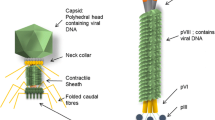Abstract
Immunoassays have traditionally relied on antibodies as diagnostic probes. Their use outside of a laboratory, however, may be problematic because antibodies are often unstable in severe environmental conditions. Environmental monitoring requires thermostable probes, such as landscape phage, that carry thousands of foreign peptides on their surfaces, are superior to antibodies, and can operate in non-controlled conditions. While parent wild-type phage are known to be extremely stable in various media at high temperatures, no work has been done to demonstrate the stability of landscape phage probes. We examined the thermostability of a landscape phage probe and a monoclonal antibody specific for β-galactosidase in parallel in an enzyme-linked immunosorbent assay (ELISA) format. They were both stable for greater than six months at room temperature, but at higher temperatures the antibody degraded more rapidly than the phage probe. Phage retained detectable binding ability for more than six weeks at 63 °C, and three days at 76 °C. The activation energy of phage degradation was determined to be 1.34×105 J/mol. These results confirm that phage probes are highly thermostable and can function even after exposure to high temperatures during shipping, storage and operation.



Similar content being viewed by others
References
van der Linden RH, Frenken LG, de Geus B, Harmsen MM, Ruuls RC, Stok W, de Ron L, Wilson S, Davis P, Verrips CT (1999) Biochim Biophys Acta 1431:37–46
Usami A, Ohtsu A, Takahama S, Fujii T (1996) J Pharm Biomed Anal 14:1133–1140
Kramer K, Fiedler M, Skerra A, Hock B (2002) Biosens Bioelectron 17:305–313
Brichta J, Vesela H, Franek M (2003) Vet Med (Prague) 48:237–247
Reiter Y, Brinkmann U, Webber KO, Jung SH, Lee B, Pastan I (1994) Protein Eng 7:697–704
Willuda J, Honegger A, Waibel R, Schubiger PA, Stahel R, Zangemeister-Wittke U, Pluckthun A (1999) Cancer Res 59:5758–5767
Steinhauer C, Wingren C, Hager AC, Borrebaeck CA (2002) Biotechniques 33(Suppl):38–45
Dooley H, Grant SD, Harris WJ, Porter AJ (1998) Biotechnol Appl Biochem 28(Pt 1):77–83
Petrenko VA, Sorokulova IB (2004) J Microbiol Methods 58:147–168
Brigati J, Williams DD, Sorokulova IB, Nanduri V, Chen IH, Turnbough CL Jr, Petrenko VA (2004) Clin Chem 50:1899–1906
Petrenko VA, Vodyanoy VJ (2003) J Microbiol Methods 53:253–262
Petrenko VA, Smith GP (2000) Protein Eng 13:589–592
Kouzmitcheva GA, Petrenko VA, Smith GP (2001) Clin Diagn Lab Immunol 8:150–160
Samoylova TI, Petrenko VA, Morrison NE, Globa LP, Baker HJ, Cox NR (2003) Mol Cancer Ther 2:1129–1137
Petrenko VA, Smith GP, Gong X, Quinn T (1996) Protein Eng 9:797–801
Romanov VI, Durand DB, Petrenko VA (2001) Prostate 47:239–251
Webster R (2001) Filamentous phage biology. In: Barbas CF et al (eds) Phage display a laboratory manual. Cold Spring Harbor Laboratory Press, Cold Spring Harbor, New York, pp 1.1–1.37
Smith GP, Petrenko VA (1997) Chem Rev 97:391–410
Wiseman RL, Dunker AK, Marvin DA (1972) Virology 48:230–244
Hoffmann-Berling H, Marvin DA, Duerwald H (1963) Z Naturforsch B 18:876–883
Meynell GG, Lawn AM (1968) Nature 217:1184–1186
Pederson DM, Welsh LC, Marvin DA, Sampson M, Perham RN, Yu M, Slater MR (2001) J Mol Biol 309:401–421
Sakaki Y, Oshima T (1975) J Virol 15:1449–1453
Hsu YC (1968) Bacteriol Rev 32:387–399
Yu J, Smith GP (1996) Methods Enzymol 267:3–27
Segal IH (1976) Biochemical calculations, 2nd edn. Wiley, New York
Kenley RA, Tracht S, Stepanenko A, Townsend M, L’Italien J (2000) AAPS PharmSciTech 1:E7
Olofsson L, Ankarloo J, Nicholls IA (1998) J Mol Recognition 11:91–93
Olofsson L, Ankarloo J, Andersson PO, Nicholls IA (2001) Chem Biol 8:661–671
Berglund J, Lindbladh C, Nicholls IA, Mosbach K (1998) Anal Commun 35:3–7
Amako K, Yasunaka K (1977) Nature 267:862–863
Schwind P, Kramer H, Kremser A, Ramsberger U, Rasched I (1992) Eur J Biochem 210:431–436
Acknowledgements
This work was supported by ARO/DARPA Grant # DAAD 19-01-10454 (to VAP) and NIH Grant # NIH-1 R21 AI055645 (to VAP). The authors thank Dr. Vitaly Vodyanoy for assistance with data analysis, and Director of AUDFS Center Dr. Bryan Chin for fruitful discussions and technical support of this work.
Author information
Authors and Affiliations
Corresponding author
Rights and permissions
About this article
Cite this article
Brigati, J.R., Petrenko, V.A. Thermostability of landscape phage probes. Anal Bioanal Chem 382, 1346–1350 (2005). https://doi.org/10.1007/s00216-005-3289-y
Received:
Revised:
Accepted:
Published:
Issue Date:
DOI: https://doi.org/10.1007/s00216-005-3289-y




